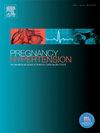先前的早产子痫前期与非妊娠状态下的止血平衡
IF 2.9
4区 医学
Q2 OBSTETRICS & GYNECOLOGY
Pregnancy Hypertension-An International Journal of Womens Cardiovascular Health
Pub Date : 2025-05-08
DOI:10.1016/j.preghy.2025.101221
引用次数: 0
摘要
目的探讨与无子痫前期病史者相比,有早产子痫前期病史(PreP)与非妊娠期异常止血特征的相关性。研究设计我们对三个经IRB批准的前瞻性研究进行了回顾性亚分析,在这些研究中,个体在怀孕外的月经周期卵泡期进行了评估。我们比较了既往PreP受试者(n = 21)与健康未分娩受试者(n = 57)和既往血压正常妊娠受试者(n = 17)的联合队列(NL, n = 74)之间的参数。采用P <;0.05为显著性。主要结局指标:在存在或不存在血栓调节素(TM)的情况下,评估8种凝血因子、蛋白C (PC)和凝血酶生成(TG)的水平,以评估抗凝血PC途径的激活。结果:健康未产者与健康初产者TG及因子组成无差异。相比之下,与没有此病史的NL组相比,PreP组的II、V、VII、IX、X、XI和PC因子水平升高。在TM存在下检测TG的动态分析中,与NL组相比,PreP组的形成速率(nM/min)和峰值水平降低。结论:促凝因子水平升高通常与TG升高相关,提示既往PreP的个体在非妊娠状态下会发生促凝因子转移。然而,观察到的抗凝血PC的同时升高与动态TG的降低相关,提示维持止血平衡可能存在代偿机制。本文章由计算机程序翻译,如有差异,请以英文原文为准。
Prior preterm preeclampsia and hemostatic balance in the non-pregnant state
Objective
To evaluate whether a history of preterm preeclampsia (PreP) is associated with abnormal hemostatic features during the non-pregnant state, relative to people without a history of preeclampsia.
Study design
We conducted a retrospective sub-analysis of three prospective IRB approved studies in which individuals were evaluated outside of pregnancy during the follicular phase of their menstrual cycles. We compared parameters between subjects with prior PreP (n = 21) with a combined cohort (NL, n = 74) of healthy nulliparous subjects (n = 57) and subjects with a prior normotensive pregnancy (n = 17). T-tests were employed with P < 0.05 accepted for significance.
Main outcome measures
Levels of eight coagulation factors, protein C (PC), and thrombin generation (TG) were assessed in the presence or absence of thrombomodulin (TM) to evaluate the activation of the anticoagulant PC pathway. Results: There were no differences in TG or factor composition between healthy nulliparous and healthy primiparous people. In contrast, the PreP cohort had increased levels of factors II, V, VII, IX, X, XI, and PC compared to the NL cohort without this history. In dynamic assays examining TG in the presence of TM, the PreP group had reduced rates (nM/min) of formation and diminished peak levels when compared to the NL group.
Conclusions
Increased procoagulant factor levels are typically associated with increased TG, suggesting here that individuals with prior PreP would have a procoagulant shift in the non-pregnant state. However, the observed concurrent increase in anticoagulant PC linked with a decrease in dynamic TG suggests a possible compensatory mechanism to maintain hemostatic balance.
求助全文
通过发布文献求助,成功后即可免费获取论文全文。
去求助
来源期刊

Pregnancy Hypertension-An International Journal of Womens Cardiovascular Health
OBSTETRICS & GYNECOLOGYPERIPHERAL VASCULAR-PERIPHERAL VASCULAR DISEASE
CiteScore
4.90
自引率
0.00%
发文量
127
期刊介绍:
Pregnancy Hypertension: An International Journal of Women''s Cardiovascular Health aims to stimulate research in the field of hypertension in pregnancy, disseminate the useful results of such research, and advance education in the field.
We publish articles pertaining to human and animal blood pressure during gestation, hypertension during gestation including physiology of circulatory control, pathophysiology, methodology, therapy or any other material relevant to the relationship between elevated blood pressure and pregnancy. The subtitle reflects the wider aspects of studying hypertension in pregnancy thus we also publish articles on in utero programming, nutrition, long term effects of hypertension in pregnancy on cardiovascular health and other research that helps our understanding of the etiology or consequences of hypertension in pregnancy. Case reports are not published unless of exceptional/outstanding importance to the field.
 求助内容:
求助内容: 应助结果提醒方式:
应助结果提醒方式:


